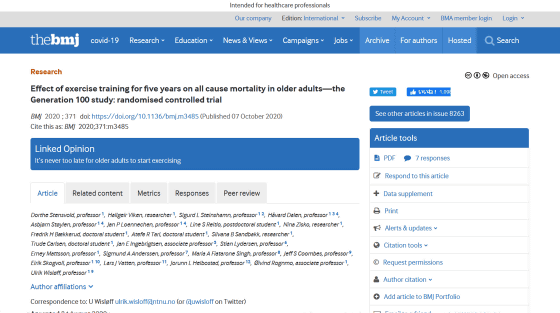Studies show that exercise intensity does not affect mortality in the elderly

Exercise is one of the most important activities in improving health, especially
Effect of exercise training for five years on all cause mortality in older adults—the Generation 100 study: randomized controlled trial | The BMJ
https://www.bmj.com/content/371/bmj.m3485

Exercise intensity not linked to mortality risk in older adults, finds trial | BMJ
https://www.bmj.com/company/newsroom/exercise-intensity-not-linked-to-mortality-risk-in-older-adults-finds-trial/
Numerous studies on exercise and health have been conducted, but there is still insufficient evidence of the potential relationship between exercise intensity and longevity. Therefore, a Norwegian research team conducted a five-year longitudinal study of the relationship between exercise intensity and mortality in the elderly between the ages of 70 and 77.
The experiment was attended by 1567 elderly people living in Trondheim , Norway. The breakdown of the subjects was 790 females and 777 males, and the average age at the start of the experiment was 73 years old.In the pre-experiment questionnaire, 87.5% answered that they were 'healthy' and 80% were medium. -It was reported that he was performing a high level of physical activity.
Of the 1567 subjects, the research team included 400 in the High Intensity Interval Training (HIIT) group, 387 in the Medium Intensity Continuous Training (MICT) group, and the remaining 780 in the Norwegian I assigned it to a group that ' exercises to the extent that it follows the guidelines for physical activity '. Each group carried out a program according to the prescribed exercise intensity twice a week continuously for 5 years.

At the completion of the five-year program, 4.6% (72) of all subjects had died. The research team compared this number with the mortality rates in the 'HIIT' group, the 'MICT' group, and the control group 'guideline level group'.
According to the research team, the combined mortality rate for the 'HIIT' and 'MICT' groups was 4.5% (35 people), and the mortality rate for the control group was 4.7% (37 people). The results suggest that 'HIIT and MICT do not affect mortality from any disease compared to the exercise intensity recommended by the guidelines,' the research team said.
At the end of the program, the overall percentage of subjects suffering from cardiovascular disease was 15.6%, but the percentage of people suffering from cardiovascular disease in the control group (16% / 125) and the 'HIIT' group. There was no noticeable difference in the percentage of (15.3% / 61 people) and the percentage of the 'MICT' group (15% / 58 people). Similarly, there was no noticeable difference in cancer and other illnesses.
In this experiment, the subjects in the control group may have had a lot of physical activity outside the program, and there were more healthy subjects than initially expected at the start of the experiment. There were some restrictions. On the other hand, the research team believes that this experiment, which has been monitoring a large number of subjects for five years, has many useful points.

Related Posts:
in Science, Posted by log1h_ik







